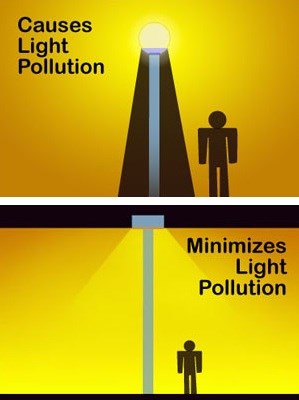
Graphic by NPS / Larry Wilson
Light fixtures that direct all light downward greatly reduce the amount of light pollution. These are referred to as shielded lights, or the engineering term full cut-off. Some light does reflect off the ground and scatter through the sky, but this has a smaller effect than light that shines directly upward. Light pollution can be further reduced by utilizing a less powerful lamp or bulb. These modern improvements in lighting not only greatly improve the quality of the night sky, but also have other benefits. These include better visibility, improved safety, less energy use, and better aesthetics.
Recent research shows that light that emitted just above the horizontal (slightly upwards) is the most likely to cause light pollution (Luginbuhl, Walker &Wainscoat, 2009). Such light that grazes across Earth's surface is several times more damaging than light that is emitted straight upward. This underscores the importance of using well-designed light fixtures with a full cut-off design.
Outdoor lighting consumes about three to five percent of electrical demand in developed countries. Depending on how light pollution is defined and the local lighting practices, the fraction of outdoor lighting that contributes to light pollution can range from 20 to over 50 percent. Thus, minimizing light pollution also achieves meaningful energy savings on a national scale and provides an economic incentive to upgrade or replace outdoor lighting with more sustainable solutions.
In some instances, even a single light can be disruptive to the natural lightscape. While one light may not affect the entire night sky, the bright point source of light can annoy neighbors (a problem called light trespass), reduce perceptions of solitude and naturalness, confuse nocturnal animals, migrating birds, and insects and spoil cultural landscapes. Even a candle seen from a mile away is brighter than each of the stars in the Big Dipper, so very small amounts of stray light can impact natural lightscapes.
References
Luginbuhl, L., Walker C., and Wainscoat, R. 2009, Lighting and Astronomy, Physics Today, Vol 62:12.
Last updated: May 15, 2025
